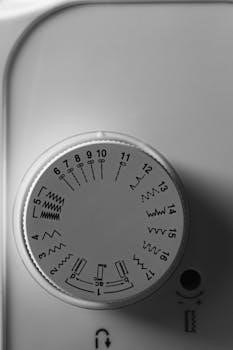
honeywell m847d-zone manual
Honeywell M847D-ZONE Actuator Overview
The Honeywell M847D-ZONE is a two-position, 24 Vac spring return damper actuator designed for direct operation of zone dampers․ It controls airflow in ducts, using a synchronous motor driven by a 24-volt switch․ It’s designed for use with ARD and ZD zone dampers, offering a reliable solution for zone control․
M847D-ZONE Functionality
The M847D-ZONE actuator operates as a two-position device, either fully open or fully closed, utilizing a 24 Vac spring return mechanism․ When energized, the synchronous motor drives the damper to its powered position, and when power is removed, a spring returns it to its default position․ This functionality is crucial for precise airflow management within HVAC systems․ The actuator is designed to integrate with a simple two-position switch, such as a wall switch or a thermostat subbase switch, making it easy to control․ The spring return feature ensures a fail-safe operation, returning the damper to its resting position in the event of a power outage․ The M847D-ZONE is specifically built for direct connection to zone dampers, enabling precise control of air distribution within a zoned system․ The actuator’s design allows for reliable and repeatable positioning of the damper, ensuring consistent airflow performance, enhancing overall system efficiency, and contributing to a comfortable and energy-efficient indoor environment․
Intended Use⁚ Zone Dampers
The Honeywell M847D-ZONE actuator is specifically designed for use with zone dampers, which are crucial components in zoned HVAC systems․ These dampers regulate airflow to different areas, allowing for individualized temperature control in various zones of a building․ The M847D-ZONE is intended for direct mounting on zone dampers, providing a reliable and precise method to control the damper’s position․ This actuator is particularly suited for systems using ARD and ZD dampers, ensuring optimal performance and integration․ By accurately adjusting the airflow, the M847D-ZONE helps optimize energy efficiency and maintain comfortable conditions in each zone․ It plays a vital role in ensuring that each area of the building receives the correct amount of heating or cooling as needed․ This precise control is essential for balanced and efficient operation of zoned HVAC systems, avoiding under or over conditioning of individual zones․

Technical Specifications of the M847D-ZONE
This section details the electrical, mechanical, and environmental specifications of the M847D-ZONE actuator․ These parameters are crucial for proper installation, operation, and maintenance, ensuring optimal performance in HVAC systems․
Electrical Ratings and Power Consumption
The Honeywell M847D-ZONE actuator operates on a 24 Vac power supply at a frequency of 60 Hz․ It has a current draw of 0․32 Amps, resulting in a power consumption of 8 VA․ This low power consumption is beneficial for energy efficiency in HVAC systems․ The actuator is designed for two-position operation, meaning it switches between fully open and fully closed positions based on the applied 24 Vac signal․ Proper wiring and adherence to local electrical codes are essential during installation to ensure safe and reliable operation․ The device’s low voltage requirement makes it compatible with standard HVAC control systems․ The synchronous motor requires this precise electrical input to function correctly, guaranteeing smooth and consistent performance, while limiting the amount of power it requires during its use, and keeping it in a safe operating range․ It’s important to verify these parameters before installation․
Motor Timing and Rotation
The Honeywell M847D-ZONE actuator features specific timing characteristics for its motor operation․ When energized at its rated load, the motor takes approximately 30 seconds to move to the powered position․ Conversely, when de-energized, the spring return mechanism brings the actuator back to its normal position in around 10 seconds․ This timing is measured at an ambient temperature of 25 degrees Celsius․ The shaft rotation of the M847D-ZONE is clockwise when viewed from the base or shaft end during energization․ The combination of precise motor timing and spring-return action ensures reliable and efficient control of the damper․ These timing parameters are important for proper system integration and must be considered when setting up zone control strategies․ The specified timings provide a predictable and dependable operation for airflow regulation․
Operating Environment and Dimensions
The Honeywell M847D-ZONE actuator is designed to function within a specific ambient temperature range of 5 to 60 degrees Celsius (40 to 140 degrees Fahrenheit), ensuring reliable performance in typical HVAC system environments․ The actuator has a multi-poise mounting position, allowing for flexible installation in various orientations․ The unit’s dimensions are detailed, with key measurements including a height of approximately 88 mm (3․5 inches), a width of 60 mm (2-3/8 inches), and a depth of 84․5 mm (3-3/8 inches)․ The drive shaft has a diameter of 8․2 mm (5/16 inch), and the anti-rotation pin is 6․4 mm (1/4 inch) in diameter․ Understanding the dimensions is crucial for proper installation and integration within HVAC ductwork systems․ The finish is zinc plated steel and anodized aluminum, providing durability․

Installation and Mounting of the M847D-ZONE
Installing the M847D-ZONE involves direct mounting to the damper shaft, with options for 5/16″ and 7/16″ couplings, and specific procedures for replacing actuators on Trol-A-Temp dampers, ensuring a secure and proper fit․
Standard Mounting Procedure
The M847D actuator can be directly attached to a 5/16″ diameter damper shaft using the output shaft’s sleeve․ For proper alignment, drill a 5/16″ (8mm) hole in the ductwork, 1-5/16″ from the shaft opening, to accommodate the anti-rotation shaft․ This ensures the actuator is firmly positioned, engaging the anti-rotation pin correctly within the warm air duct․ The damper shaft should be of suitable length to firmly hold the actuator․ Refer to the provided diagrams for critical dimensions․ When mounting, never attempt to rotate the actuator by turning the connection coupling or the damper shaft when connected, as this can cause damage to the gear train․ Always disconnect the power supply before installation or wiring to prevent electrical shock․ Confirm the product is suitable for your application, and ensure all wiring complies with local codes․ The installer should be a trained technician, and the actuator’s operation should be checked after installation․
Alternative Mounting for 7/16″ Couplings
For dampers utilizing a 7/16″ coupling, an alternative mounting procedure is required․ Before installing the M847D actuator, insert the provided drive shaft extension into the actuator’s drive shaft and secure it using the set screw․ Additionally, attach the anti-rotation extension to the end of the anti-rotation rod․ After these extensions are in place, the actuator can be installed onto the damper․ Secure the connection by tightening the coupling screw․ This method ensures a secure and correct fit for dampers with the larger 7/16″ coupling style․ Always consult the provided diagrams for visual guidance․ Remember to avoid rotating the actuator by turning the coupling or damper shaft when connected to prevent any damage․ Before beginning the installation, ensure that the power supply is disconnected, and always adhere to local electrical codes․ Proper installation is crucial for optimal performance and safety․ The installer must be a trained professional․ Verify the actuator’s operation after installation is complete․
Replacing on Trol-A-Temp Dampers
When replacing the M847D actuator on a Trol-A-Temp ARD damper, begin by using a 1/8 inch hex wrench to loosen the motor coupling from the blade shaft․ Remove the old motor assembly carefully․ Observe the position of the damper blades, noting whether they are in the normal spring-open or spring-closed position․ Place the new M847D actuator onto the shaft, ensuring that it is correctly aligned and then tighten the coupling․ For Trol-A-Temp ZDS or ZDB dampers, use a 3/16 inch hex wrench to loosen the Allen screw located above the faceplate at the motor coupling․ Note the position of the damper blades, ensuring they are open, with the setscrew pointing toward the damper label․ Attach the new motor to the coupling, ensuring the standoff on the motor is positioned correctly in the grommet․ After replacing the actuator, always verify that the equipment operates as intended, confirming that the damper moves properly when power is applied and removed․

Operation and Airflow Adjustment
The actuator powers the damper to a closed or open position when 24 Vac is applied․ When power is removed, the actuator uses a spring to return to its normal position․ Airflow can be adjusted with levers․
Powering the Actuator

The Honeywell M847D-ZONE actuator operates on a 24 Vac power supply, typically drawing 0․32 amps at 50/60 Hz․ This low voltage design ensures safe and reliable operation within residential and commercial HVAC systems․ The actuator is designed as a two-position device, meaning it moves between a fully open and fully closed position, dictated by the power signal it receives․ The power is typically delivered through a two-position switch, which can be a simple wall switch or a thermostat subbase switch․ When the 24 Vac power is applied, the internal motor engages, driving the damper to its energized position․ Upon removal of the power, a spring mechanism returns the damper to its default position․ This spring-return action is a key safety feature, ensuring the damper will revert to its normal state in case of power loss․ Ensuring the correct wiring and voltage is crucial for proper functioning․
Adjusting Airflow with Levers
The Honeywell M847D-ZONE actuator incorporates adjustable levers to fine-tune the airflow through the connected damper․ These levers, typically located on the actuator body, allow for a range of adjustments to both the open and closed positions of the damper․ Specifically, the lower lever controls the damper’s position when de-energized, adjusting how far the damper opens when the motor is not powered․ Moving this lever to the right restricts the airflow in the open position․ Conversely, the upper lever controls the damper’s position when energized, allowing adjustment of the closed position․ By moving this lever to the left, you can prevent full closure of the damper․ These adjustments can be locked in place with wing nuts․ The levers provide flexibility in managing airflow within different zones of a building․
Leave a Reply
You must be logged in to post a comment.